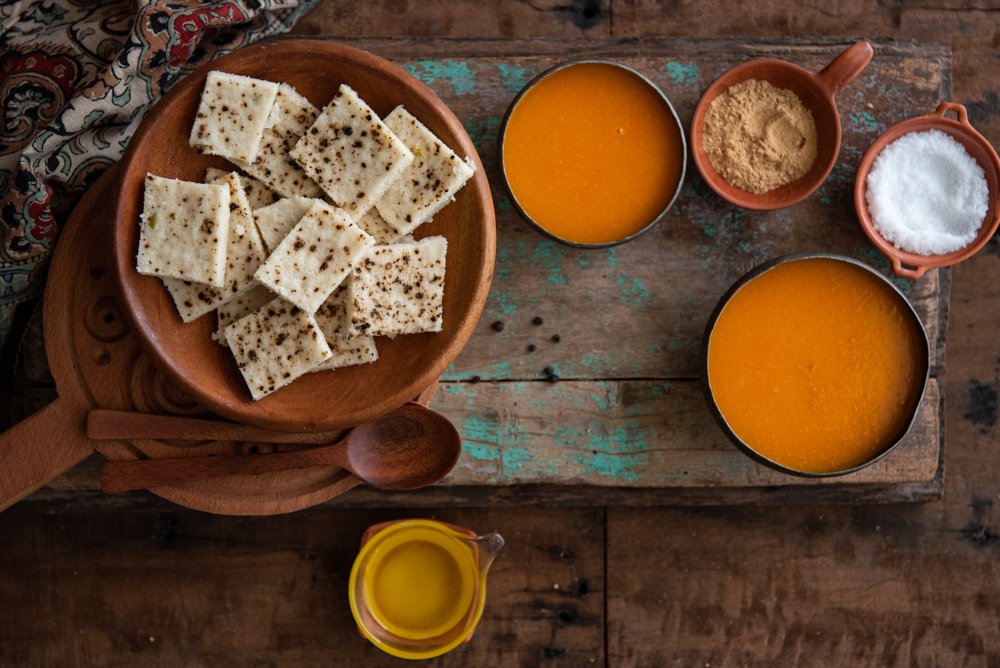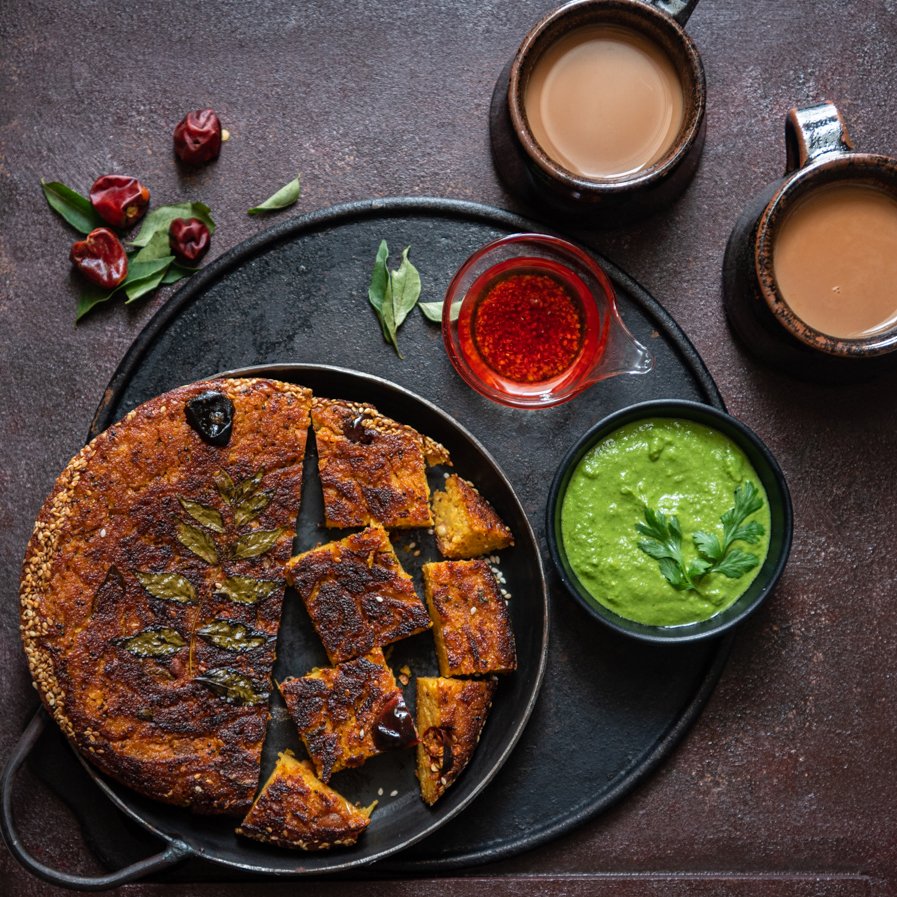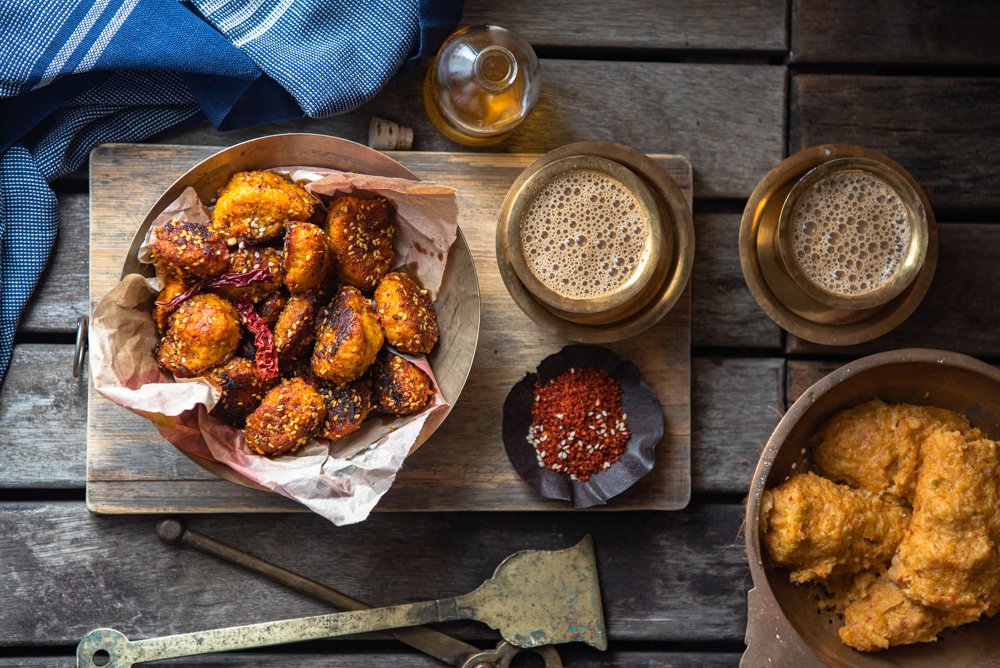Nasto, Farsan And The Pursuit Of The Perfect Snack
Text by Chaitali Patel
Photographs by Sheetal Bhatt
Always freshly made and often tweaked to suit the season, farsan like idada elevate the simple staples of a Gujarati meal. As pictured above, idada is often paired with aam ras (or mango pulp) when the fruit is in season.
On visits to my mother’s home, it’s always between 3 and 4 p.m. when a cabinet in her kitchen exudes a strong magnetic pull, luring me towards it. Inside sit plastic jars and repurposed glass bottles filled with a variety of nastas, as Gujarati snacks are called. I am tempted to eat a little of everything, but better sense prevails and I make my pick for the day. My choice is governed by my willpower or the lack of it. Nastas are deep fried, mostly savoury snacks, which occupy pride of place in any Gujarati household.
In Hindi, nashta means breakfast, whereas in Gujarati, nasta or nasto refers to a wide spectrum of snacks that are meant to satiate anytime hunger cravings, and are typically eaten between meals.
“While crisp deep-fried snacks, frequently based on besan (chickpea flour) are popular all over India, Gujarat has a special generic term for them, nasto,” writes the late food scholar K. T. Achaya in A Historical Dictionary of Indian Food.
Why does Gujarati cuisine feature such a wide array of snacks? According to Bindu Danthi and Ruxmani Danthi, authors and home chefs who are also sisters-in-law, the answer is simple: “Gujaratis love to eat.”
A number of other communities make similar claims, but the sheer variety of Gujarati snacks is undoubtedly unique. The love for something crisp and savoury runs so deep that even main meals feature an extra item or two. Known as farsan, these dishes elevate a regular meal comprising the staple dal, bhaat, rotli, shaak (dal, rice, wheat-based flatbreads and vegetables). In fact, no celebratory or festive meal is complete without a couple of farsan such as kachoris, dhokla or khandvi.
According to the Danthis, farsan is derived from the word farsu, which they say roughly translates to a dish that is savoury — slightly salty and spicy. Sheetal Bhatt, a food blogger and writer who documents the native foods of Gujarat, says that the word refers to the texture of the dish, particularly the crisp and crunchy element.
Crunchy or not, there’s no disputing that farsans transform an everyday meal. They are almost always freshly made and served hot— unlike nastas, which can be bottled up and kept for days.
Often confused to be the same thing, farsan and nasta refer to different dishes.
“Nasta, mostly dry in nature, are unlikely to be served as farsan, Bhatt says. On the other hand, farsan can be eaten as part of a main meal, by itself as a meal or even as nasta. But the line demarcating the two is not a rigid one.”
***
Gathia is a popular kind of nasto. In the arid Kathiawar region of Gujarat, where fresh vegetables are often hard to come by, it is used to make gathia nu shaak.
On rushed mornings, nastas can easily substitute for a cooked breakfast. My mother has a couple of khakras for breakfast almost every day. It’s not a paucity of time but convenience that governs her choice. Thin discs usually the size of a quarter plate, khakras are made by roasting rotis on a hot griddle till they take on a flaky, cracker-like texture. They can be eaten plain or with a schmear of ghee and a sprinkling of jeeralu (roasted cumin powder); with flaming red methia no masalo, a Gujarati pickle masala, or athela marcha – chillies stuffed with pungent ground mustard. What can be paired with a khakra depends entirely on the person eating it.
Like khakras, other Gujarati snacks are also versatile. Although simple in appearance, serious expertise goes into making them. Varying the technique changes the end result at times, creating a whole new dish. The humble sev, a ubiquitous snack made of deep-fried besan, takes on many avatars when changes are made to the batter. Adding a few ingredients and altering the consistency of the batter allows for different thickness and varieties of sev. Jaadi (or thicker sev) is eaten as is. Jhini or nylon sev — referring to the fine texture of the sev — is sprinkled on dishes for an extra crunchy element.
Another popular variation is gathia. Made of besan, these can be stubby and powdery or oblong and hard. Commonly flavoured with ajwain or carom seeds, gathias are a favourite with children. Spicier versions are also available and often cooked with tomatoes and spices to make a quick shaak or vegetable dish.
Of the different varieties of gathias, Bhatt says Bhavnagari gathias, named after a town in eastern Gujarat, are considered the best. In her blog, theroute2roots, she writes: “Gathiya Nu Shaak is a very popular Kathiyawari dish. Kathiawar being a dry and arid region, the availability of fresh vegetables remains limited and hence food preparations using sun-dried foods and farsan/snacks is very well weaved in the Kathiyawari cuisine.”
The same besan, when kneaded into a dough, stretched out into flat strips and deep-fried, becomes fafda. The magic lies in the method. Traditionally, the dough is rolled out into broad, long strips by hand to ensure even pressure is applied. Their surfaces marked with bumps, fafdas are usually eaten with kacha papaya no sambharo, a relish made with grated raw papayas tempered with mustard seeds, green chillies and hing or asafoetida.
On the morning of the tenth day of the annual Dussehra festival, queues snake outside fafda shops in Gujarat. Hot fafdas straight from a sizzling kadhai are wrapped in newspaper at a lightning pace. The parcels of fafda packed with sambharo and cloyingly sweet jalebis fly off the counter and are quickly transported home for the entire family to feast on.
***
Given the time and finesse required to make farsan such as dhokla, khandvi and handvo (pictured above), they are often store bought.
Of the different kinds of farsan, dhoklas and khandvis are the most well known, eaten widely even outside the state of Gujarat.
“Afternoon tea is an occasion for enjoying Gujarat’s delicious snacks called farsans. An emblematic Gujarati dish is dhokla, a steamed dish of fermented legumes,” writes Colleen Taylor Sen in Feasts and Fasts: A History of Food in India.
Pillowy soft dhoklas are made with a combination of grains and lentils that are soaked and ground. Fermented with buttermilk, the batter is steamed and cut into pieces. The finishing touch is a tempering of mustard seeds and green chillies in oil. According to Bhatt, the most commonly eaten dhoklas are made with rice and chana dal.
During mango season, when ras (or mango pulp) is enjoyed every day, she says idadas, a farsan made with rice and urad dal, makes for a good pairing.
The inventiveness of Gujarati cuisine is possibly best reflected in the tightly rolled layers of khandvi, a dish that is all about mastery of technique. Also made from besan, it is the treatment that results in a completely distinct dish, both in taste and texture. Besan, along with ginger-green chilli paste, turmeric, hing and lemon juice is mixed with yoghurt and water. The mixture is brought to a simmer and cooked till it thickens, and then spread out onto a greased thali. Once it cools, it’s carefully scraped out, rolled tightly and cut into bite-sized pieces.
Trays of bright yellow khandvi sprinkled with grated coconut and coriander make an appearance around tea time in stores selling packaged nastas and fresh farsan. Given the effort that goes into making khandvi, it’s no surprise that it is often store bought.
***
According to Bhatt, a Gujarati thali is usually a showcase of the dishes that a community or family is most proud of. (A thali is a meal with many components, all served together on one platter. Most regions in India have their own take on the thali). That’s probably the reason why so many dishes feature as part of one meal in a Gujarati thali. Seasonal produce is almost always incorporated into a variety of shaak and farsan.
When colocasia leaves are in season, it is patra time. A batter of besan is slathered onto the large leaves, which are then rolled and steamed. The steamed logs are cut into pieces and then tempered or deep-fried.
Winter is the best time to visit Gujarat if food is your priority. In the colder months, laris or push carts piled high with heaps of bright green peas, tuver (fresh pigeon peas), methi (fenugreek leaves), ratalu (purple yam), shakariya (sweet potatoes) and more are a common sight across cities and towns in the state.
Tuver pods speckled with distinctive purple marks are a winter speciality used in a variety of shaak, farsan and even kadhis (gravies made of buttermilk, thickened with besan). The peas are often frozen to be enjoyed later, long after the season has ended. The minute they arrive on the market, a stuffing of coarsely ground tuver mixed with a garlic and chilli paste replaces the spiced lentil mixture normally used to make kachoris or ghughras (deep-fried or baked turnovers filled with savoury or sweet ingredients). It’s the time of the year, when dhoklas — otherwise a perennial staple on thalis — make way for a celebration of seasonal produce such as methi na gota and methi na muthiya (both made of fresh fenugreek leaves), lilva na ghughra (made of green tuver), ratalu na pattice (made of purple yam) on thalis.
Muthiya often features fresh methi or fenugreek leaves, and is a vital component of undhiyu.
Crisp on the outside and spongy within, methi na gota are small bites of deliciousness. The bitterness of the tender methi leaves is balanced with sugar or the addition of an overripe banana to the batter. (The combination of savoury and sweet flavours is a distinctive feature of most regional cuisines in Gujarat). Methi also goes into making steamed or fried muthiyas. Probably named after the fact that the thick batter is shaped with the muthi or fist, muthiya is denser than gota in texture. It is an integral part of undhiyu, a quintessential Gujarati winter delicacy made with a medley of winter vegetables.
I eagerly look forward to going to a simple, fuss-free, canteen-style thali restaurant down the lane from my mother’s house in Ahmedabad, which has only one thing on the menu — an all-you-can eat Gujarati thali. In addition to the variety of vegetables, flatbreads and rice, the different kinds of farsan make my heart sing. They are served piping hot and at such speed that it’s the one time I don’t pay attention to how many ghughras, kachoris or pattice I am eating. Sitting there with the family in tow, with the clanging of stainless steel utensils as tables are set and cleared adding to the din, indulgence of every kind seems legitimate. Any guilt on account of eating so many deep-fried foods is assuaged by the thought that eating seasonally must be a good thing.
***
Traditionally, most people in Gujarat lived in joint families, with the women of the household sharing the responsibility of cooking. Through marriage, new members came into the family, bringing with them culinary recipes from their maternal homes. The result was a commingling of ideas and techniques in the kitchen, resulting in many experiments and new dishes. In their book titled Farsu etle Farsan, the Danthis share over 150 recipes for farsan, a combination of those passed onto them from their mother-in-law and those made in their respective maternal homes.
Today, the food that is cooked and eaten across homes in Gujarat has undergone several changes. The desire to eat healthy has changed how we cook. Bhatt rues that as people increasingly abstain from oily foods, a number of traditional recipes that are deep-fried or use oil generously may eventually be lost. Those that yield to the oven and air fryer are more likely to remain on our plates.
Bhatt also feels that there is a shift towards eating food that is aspirational — and is therefore perceived as socially acceptable. According to her, a packet of crisps does not undergo the same scrutiny that a perfectly flaky ball of kachori may be subject to.
***
On my visits home, along with eating my favourite dishes, I always stock up on nastas to carry back with me. From Induben Khakrawala, a well-known culinary enterprise started by Induben, an Ahmedabad-based homemaker, to supplement her family income, to Falguni Gruh Udyog and Satyam — neighbourhood establishments that work with women cooperatives — almost every household has its own preferred nasta store. Entering one of these stores is akin to walking into a treasure chest, where every visible inch of space is covered with packets of nastas, pickles, mukhvas (or mouth fresheners), ready mixes, and more. These stores go the extra mile to make sure that customers from out of town can carry back their goods intact. For a small extra fee, packaged khakras can be specially vacuum packed, ensuring that they don't crumble while being transported. The process also helps increase their shelf life.
Bhatt prefers to buy her nastas from select gruh udyogs, small collectives of women who make an assortment of foods in community kitchens and typically on a smaller scale. Making things by hand is a norm rather than an exception here.
Home chefs like the Danthis also take on orders and are able to accommodate specific requests like altering spice levels or making special provisions to cater to allergies or other dietary restrictions.
Given the easy availability of readymade nastas, fewer and fewer families make them at home. Festivals are the rare occasions when a couple of nastas may be prepared. Given the amount of effort that goes into making nastas and farsans, they are undoubtedly a labour of love. A small cube of bouncy dhokla belies the time and work that has been put into it. These seemingly simple, traditional recipes are based on years of wisdom of what should be eaten, when and how.
Made at home and by hand, there was almost always only a small quantity available for each family member. However, modern-day abundance has triggered more consumption, tipping the balance and earning many of these dishes, unfairly perhaps, an unhealthy label.
The popularity of farsan is also an important cultural marker of urban affluence. According to Bhatt, the staple of dal-bhaat-roti-shaak takes precedence over labour- and resource-intense farsan in rural areas.
***
However, a thali is a sum total of its many parts, with each dish playing a small yet vital role. If a few of these crunchy, flavourful elements were taken away, the symphony of flavours would be missing a few notes.
According to Bhatt, farsan and mithai form the fulcrum of a Gujarati thali and all the other dishes are planned around them. Given the time, effort and technique that goes into making both, she feels that they are the best reflection of the maker’s skills. Mastery over farsan and mithai is gained by practice, and they are prized skills that are an enviable heirloom.
By documenting these dishes and the stories behind them, she hopes to ensure they are not lost forever. She says cooking is about so much more than the food on our plates. It helps us forge links to the people who cultivate the ingredients and make them available to us. It also makes us conscious of what and how we consume, which is more critical now than ever before.




